Keep the Far-Right Out of London Government
City Hall, London. April 28, 2008
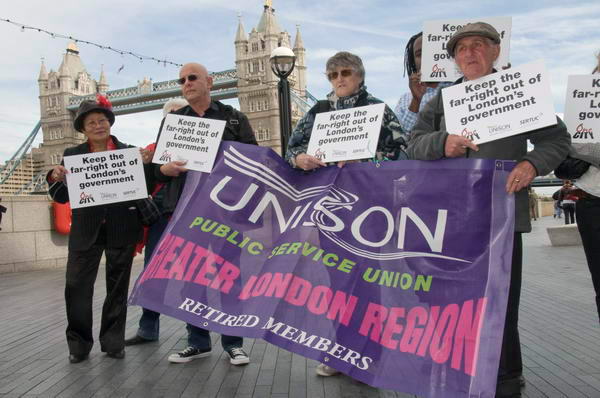
more pictures
The TUC called called for Londoners to oppose the election of a far-right
representative to the London Assembly with the formation of a symbolic 'Ring
of Democracy' around City Hall on Monday lunchtime. Some of those taking part
were also at the Workers Memorial Day rally, and the event was held back while
this was taking place.
It was supported by trade unions, community groups, faith leaders and individual
Londoners, although the closure of City Hall caused by a burst water main
meant that there were no workers inside the building to lend their support.
After a few short speeches which stressed the progess made by the GLA in community
relations and equal opportunities and the dangers posed by the far-right to
the future of Londoners.
Unfortunately three days later on May 1, a majority of the 45% of those eligible
to vote did so in favour of Boris Johnson for Mayor, and the BNP acheived
the 5% of votes required to give them their first assembly member.
more pictures
Workers Memorial Day, 2008
Southwark, London. April 28, 2008
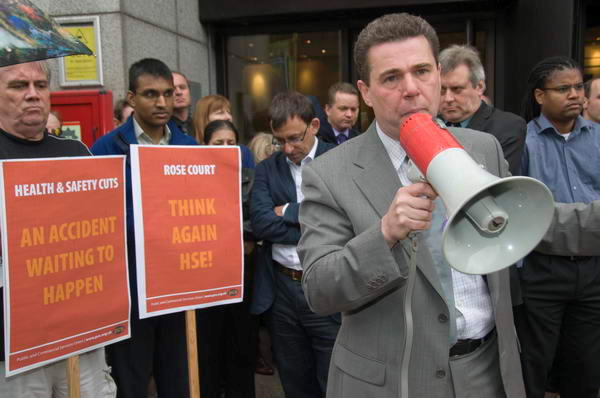
Mark Serwotka condemns the decision to lose much of
the expertise of the HSE by closing its London Office.
more pictures
Too many workers are killed at work. Too many killed because of the failure
of employers to implement proper safety procedures. Too many because of rogue
employers who flout safety laws to increase profits - and get away with murder
because our legal system is stacked against workers. Laws to make clear the
employer's responsibilities are ugently needed, as is a proper system of enforcement.
We hear far too much about the nonsenses caused by health and safety regulations
(often wrongly interpreted or simply put forward as excuses for unpopular
actions), but far too little about the need for proper protection for workers
- and the need for a tight inspection system to ensure safety at work.
The International Workers Memorial Day March in London stopped outside the
offices of the HSE near Southwark Bridge, where they were joined by over a
hundred employees protesting about the planned closure of the office and its
move away from London. Only a very few employees are willing to move, and
the transfer will result in a loss of a great deal of experience in inspecting
workplace safety.
As well as the union speakers at the rally held in the scoop at City Hall,
there were two speakers whose presence underlined the human tragedy behind
the terrible statistics. The deaths of Simon Jones and Andrew Hutin were not
accidents, but a result of deliberate flouting of safe working practices and
those responsible have not been brought to justice.
Anne Jones described movingly how her 24 year old student son Simon
Jones was killed 10 years ago, in April 1998, on his first day of work
as a casual worker at Euromin's Shoreham dock, his head crushed by the grab
of a crane. He had been sent there by an employment agency that had failed
to make the checks legally required that the job was safe for him. The grab
that killed him had been modified to save time, making it unsafe. The campaign
started after his death has been a major force in bringing the problem of
workplace deaths to public attention, and eventually forced a trial in which
Euromin and its manager James Martell attitude to safety was described by
the judge as "absolutely deplorable" and giving "wholly insufficient
thought and attention" to safety, although unfortunately the jury failed
to convict on amanslaughter charge.
Andrew Hutin of Families Against Corporate Killers (F.A.C.K.)also
brought tears to my eyes as he spoke about his young son Andrew's death in
a blast furnace explosion at at Corus, Port Talbot, South Wales in 2001 -
and you can read more about his case and others on their web site. F.A.C.K.
describe themselves as "a group of families angry and frustrated as employers
seem to be getting away with murder." Many employers still are, and we
should all be angry about it, even if our own families are fortunate not to
have been bereaved.
more pictures
Vote Zombie
London Bridge, London. Monday 28 April, 2008
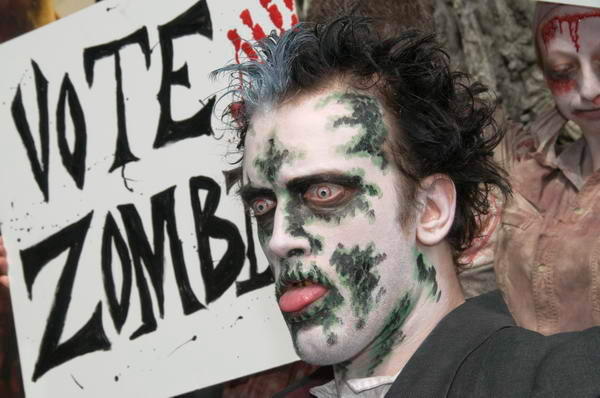
more pictures
A better choice for London than Boris! A publicity stunt for a tourist attraction
at London Bridge with a zombie Mayoral candidate for the London election.
more pictures
Londoners For Peace Support Ken
Altab Ali Park, Whitechapel. Sunday 27 April, 2008
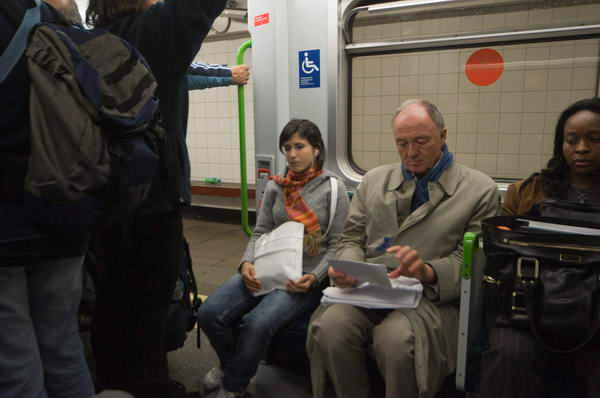
Ken Livingstone on his way home from the rally
more pictures
Peace campaigners and local community activists in Tower Hamlets joined together
for a rally to support Ken Livingstone in his attempt to be re-elected
as mayor of London.
The event was chaired by Bruce Kent, and speakers included a number
of well-known names, including Tony Benn and Walter Wolfgang
who I photographed as they talked together about the future prospects of the
Labour Party. I liked Benn's view that the demise of Gordon Brown would mean
the end of Thatcherism.
Most of the speakers praised various aspects of Ken Livingstone's work for
London, and particularly his commitment to getting London's different communities
to work together, some contrasting this with Boris Johnson's appalling use
of expressions such as "water melon smiles" and "picanninies"
and his apparently racist comparisions of the Iraqis and Americans and other
anti-Islamic statements.
Ken was also praised for his consistent support for the anti Iraq war movement,
as well as his work with peace campaigners to oppose nuclear weapons and Trident
replacement (Boris supported the war and Trident replacement.)
Designer Vivienne Westwood was the only woman to speak before I
left the event. She has long been an ardent member of the peace movement.
George Galloway spoke next, in his usual forceful manner, urging
people to support Ken in the election. His decision not to stand against Ken
so as not to split the vote won praise from several others who spoke as an
unfortunately rare case of a politician acting from conviction.
Anas Altikriti, who was president of the Muslim Association
of Britain in 2004-5, and a leading member of the anti-war movement,
spoke after Galloway, and while he was speaking, Ken Livingtone himself arrived.
Ken, despite the worry he must have about Thursday's election, was if anything
more cheerful and upbeat than ever. He has a peculiar diffidence that seems
very appealing - and he even apologised about asking everyone to vote for
him - after making clear exactly why he felt that Johnson would be a tragedy
for London.
After speaking, he was warmly congratulated by the other speakers, particularly
by George Galloway, and was soon surrounded by a crowd of well-wishers, many
wanting to be photographed with him. After a few minutes, the stewards led
him away through a back entrance into the flats at the back of the park.
My photographs of London owe a great deal to Ken Livingstone and his transport
policies at the GLC in the 1980s that made a quantum change in transport across
the capital. It's hard now to imagine the difficulties and of getting around
the city before the Travelcard - assuming you aren't in the class that always
travels by taxi.
As Ken left, I decided it was time for me to go as well, and I wasn't at
all surprised to find myself following Ken into Aldgate East underground station.
I sat down ont he train next to him, and after talking briefly asked if he
would mind if I photographed him on the tube.
During the few stations to Embankment, where we both changed, he sat there
catching up with reading a few documents. Several groups of people - including
some Norwegian tourists - came up and talked to him and some took photographs
too. As always, Ken had a smile and a few words that made them all feel welcome.
more pictures
Manor Park Nagar Kirtan
Manor Park, London. Sunday 27 April, 2008
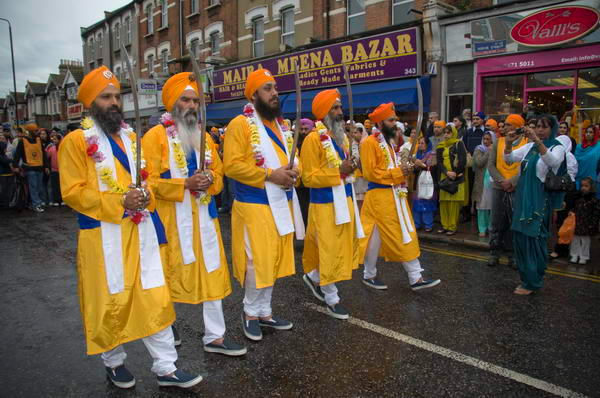
The Panj Piyaras walk in front of the Guru Granth Sahib
at the head of the Procession
more pictures
Sunday's Nagar Kirtan from the Gurdwara Dasmesh Darbar in Manor Park, E12
was the third procession to celebrate Vaisakhi and the creation of the Khalsa
that I've photographed this year (the other two were at Hounslow and Woolwich.)
It's always an exciting and colourful event, and the people always make me
feel welcome.
Each of the Gurdwaras has its own distinctive feel and although the basics
of the event are the same, there are differences between the events (and those
I've been to elsewhere in other years at Slough and Southall) - and of course
the locations - that add to the interest.
It was a dull day this year, and as the procession started, so too did a
light rain, which soon became rather heavier for a few minutes. I'd removed
my shoes (and knotted a saffron scarf over my hair) to photograph on the carpeted
area of road in front of the Gurdwara when the Guru Granth Sahib was carried
out to the decorated float for the procession, and by the time I'd walked
a couple of hundred yards with the procession and found time and space to
put them back on again, my socks and feet were rather wet. Another year I'll
take my socks off as well if it looks like rain.
Fortunately the rain eased off after a few minutes, then more or less stopped
as the procession moved up High Street North, and more people joined in. By
the time I left it on Romford Road it was a tightly packed mass of 10,000
or more. I stopped to eat a plate of rather tasty free food, watching the
people go by, and after I'd finished they were still coming in a dense crowd
along the road. I made very slow progress against the flow, taking the occasional
picture and photographing the drummers and lorries with the elderly enjoying
the occasion at the back of the procession.
more pictures
Bromley area May Queens Crowning
Bromley, London. Saturday May 26, 2008
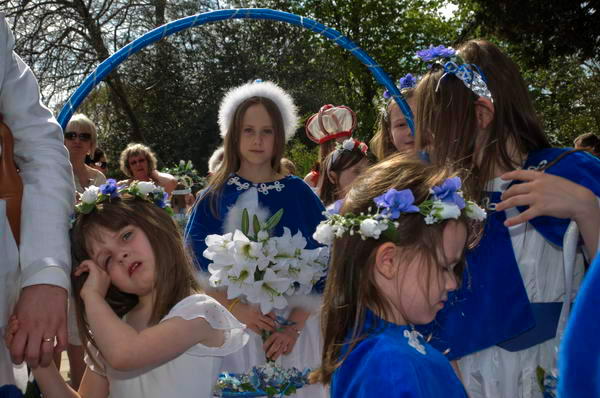
After the crowning ceremony in Church House Gardens
more pictures
It was a glorious Spring day, the warmest of the year so far, for this year's
May Queens from around Bromley with their retinues to make their colourful
procession to Church House Gardens next to the Churchill Theatre in the centre
of the town for the crowning ceremony. May Queens present included those from
Bromley Common, West Wickham, Shortlands, Hayes, Hayes Village and Hayes Common,
as well as the London May Queen who crowned those from Bromley Common and
Shortlands during the ceremony. I photographed the crowning of the three Queens
from Hayes last week.
more pictures
Ethnic Catering Alliance - Save the British Curry Industry
Trafalgar Square, London. Sunday 20 April, 2008
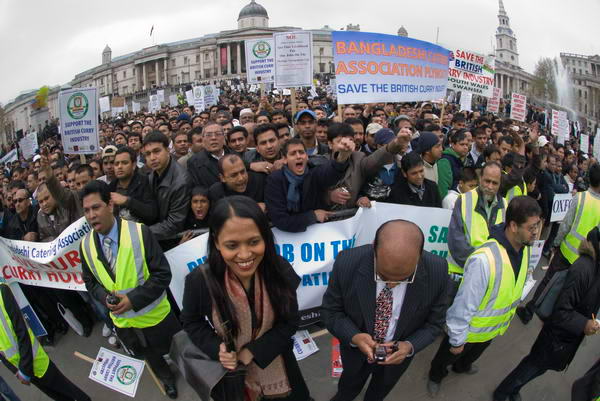
Trafalgar Square full of protesters
more pictures
Tough immigration controls are threatening our English way of life which
has become totally dependent on restuarants and cafes serving such 'ethnic'
delights at Chicken Tikka Masla. English food used to be a laughing stock,
now thanks to the many Indian, Chinese and other cuisines (as well as uniquely
English dishes such as CTM) it attracts tourists to the country. But our government
has plugged the flow of cheap labour from Bangladesh, India, Hong Kong, Turkey
and elsewhere that has brought cooks, waiters and others to this country to
work at below minimum income rates and make this - and fat profits for the
ethnic owners of these restuarants - possible.
Our government is happy to see our sweet and sour cooked by Polish unskilled
labour, refusing to recognise that chefs from the sub-continent have skills
that we need. Our BIA migration enforcers see ethnic restuarants as easy targets,
swooping on Chinese or Indian restuarants in lightning raids in an attempt
to meet their quotas for arrests and deportations, disrupting their business.
How many of us carry documents with us that prove we have a right of abode
in Britain? But if you work in an Indian or Chinese restuarant you really
need to, or face at best a lengthy bout of questions and at worse find yourself
en route to a detention centre.
Too many people wanted to speak at the rally, though fortunately quite a
few failed to make it to the platform when called. Those who did speak included
politicians such as Tony Benn, Jeremy Corbyn, Simon Hughes and George Galloway
as well as many British Asian politicans and would-be politicians hoping for
support in forthcoming elections. This was a rally with widepsread support
from across the communities; most of us relish at least the occasional curry,
kebab or Chinese.
Breaking up the speeches were performances by Chinese lion-dancers and a
Bangladeshi cultural group from East London.
more pictures
Crowning of the Hayes Realms
Hayes, Bromley, London. Saturday 19 April, 2008
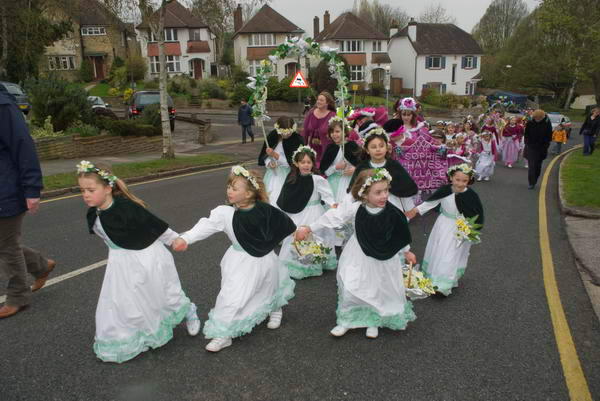
The procession around Hayes
It was the work of Tony Ray-Jones that first attracted me to May
Queens, with his posthumous 'A Day Off', published in 1974 containing
half a dozen of his pictures from May Queen festivals (though only four really
connected with May Queens.) One of these - certainly the least interesting
image - showed around 30 young women in three rows in front of a maypole,
all wearing crowns. Despite the misleading caption, 'May Queen Gathering,
Sittingbourne, 1968', in a later publication it was identified correctly
as a picture of the annual London May Queen festival at Hayes, Kent.
Although I didn't think it one of his better pictures it struck me as an
interesting event, and even more so when I went to photograph it in 2005,
and started to look up a little of its history.
Since then I've photographed a number of other May Queen events in southeast
London and elsewhere, with invitations from several of the people involved,
including the Chislehurst
May Queen organisers and the 2007 London
May Queen, who I photographed at Bromley. In fact I've enough pictures
for an exhibition (and it very nearly happened at a major institution this
year) or a book, though I'm still keen to take more.
Saturday I went to Hayes for the crowning of the three local May Queens -
Hayes, Hayes Village and Hayes Common. This year's
London May Queen - to be crowned next month - is also from Hayes
and was also taking part in the event. It was a cold, grey day with just the
odd spot of rain in the air, but it was still a lively and colourful event
and I enjoyed taking pictures of people - children and adults obviously enjoying
themselves. After the crowning and a parade around Hayes, the children enjoyed
a noisy disco and then had the kind of unhealthy tea they like.
more pictures
Demo at Kalyx Supports Harmondsworth Detainees
Capital House, Chapel St, London. Wednesday 16 April, 2008
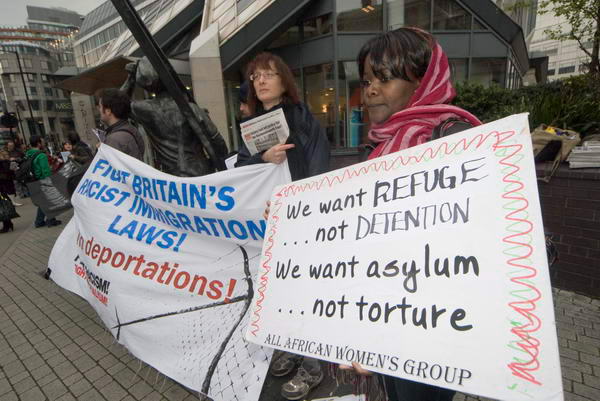 more
pictures
more
pictures
On April 1, around 300 detainees went into the exercise yard of Harmondsworth
Immigration Removal Centre to protest about their detention and poor conditions,
signing a petition which was sent to the European Court of Human Rights. Their
peaceful protest included a hunger strike.
Around 5 am on April 5, roughly 50 riot police stormed the centre to break
the hunger strike, manhandling the detainees and taking around 30 of them
away to solitary confinement and prisons.
New fast-track procedures mean they have only 5 days to prepare their cases
and two days to appeal, and they are unable to get proper legal representation,
complaining that the lawyers provided are more interested in getting them
deported than in ensuring that their cases are properly heard. Being held
inside the centre also prevents many of them from putting together evidence
vital to their cases. Almost all - perhaps 99% - are refused in what appears
to be essentially a rubber-stamp exercise, and few appeals are succesful.
Food and living conditions in the privately run centre are extremely poor
and there are no proper medical facilities. The centre is run by the private
company Kalyx (formerly UK Detention Services), a subsidiary of French-based
multinational company Sodexo. According to a Bloomberg feature, Sodexo made
an operating profit of 50 million euros in the UK and Ireland, with an operating
margin of 6.1%.
Around 25 people turned up to hold banners and hand out leaflets outside
Capital House, the London offices of Kalyx, next to Edgware Road (Circle Line)
underground station for a demonstration to show solidarity with the detainees
organised by No Borders London. There was one police car parked next to the
offices, and one of the officers got out to ask for a leaflet, but shortly
afterwards they drove off. A number of security men strolled up and down inside
the entrance lobby, but didn't come out to talk to the demonstrators while
I was there.
One man, possibly also from their security, hung around for the first half
hour of the demo, rather obviously trying to look inconspicuous; at one point
he obviously came to eavesdrop on the 3 press photographers present - but
I'm afraid he would have found our conversation unedifying in the extreme
- unless he really wanted to know about Marc's new Nikon D300 or my new Panasonic
SDR S7 camcorder...
more pictures
April Bio-Fools Day, London
Downing St, London. Tuesday 15 April, 2008
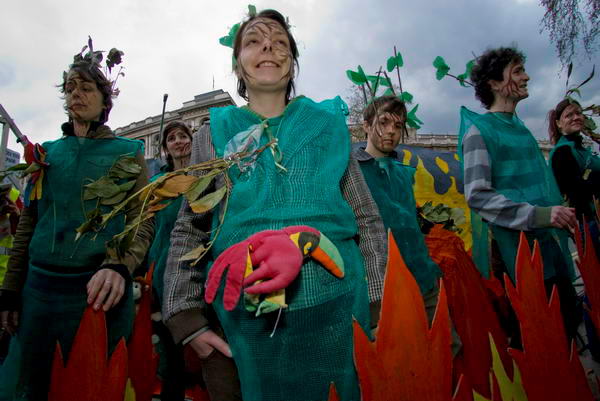
Protesters opposite Downing St
more pictures
Mandatory biofuel blending (RTFO) under the UK government Renewable Transport
Fuel Obligation (RTFO) came into force today, and a demonstration was organised
by Biofuelwatch and the Campaign Against Climate Change to point out the unfortunate
consequences thiw will have. Although biofuels sound as if they should be
a good green alternative, in practice this is not so.
Biofuel production takes land away from food production, increasing food
shortages and prices. The increased commercial agriculture they bring in will,
according to UN predictions, result in human rights abuses and 60 million
people being forced off their land.
Biofuel production will have disastrous effects on the rainforests, some
of which have already been cleared by burning to produce biofuels; the destruction
of these and other habitats will lead to many species becoming extinct.
In terms of climate change, agrofuels (commercially farmed biofuels) are
a disaster, in almost all cases their production having a heavy carbon footprint
that outweighs any benefit. Biofuels only make sense where they are basically
using waste products from food production.
Among the demonstrators were two men from West Papua. Their country gained
independence from Dutch rule in 1961. Three months later, Indonesia invaded.
The international community intervened, but thanks to US cold war mania about
the possible spread of communism, Indonesia were allowed to remain and conduct
a sham referendum in 1969 in which over a thousand Papuan 'representatives'
were forced at gunpoint for their country to be a part of Indonesia.
Benny Wenda, a West Papuan tribal leader was arrested, imprisoned and tortured
for campagining for a free West Papua.
He escaped and came to the UK and is Chairman of Denmak, the Papaun People's
Tribal Assembly. West Papua is half of the second largest island in the world,
and home to the second largest tropical rainforest in the world, one of the
areas threatened by biofuel production.
Several West Papuan flags were flying opposite Downing St, an act punishable
by ten years in prison in West Papua.
more pictures
Global Day Of Action For Darfur
Sudan Embassy, St James's, London. Sunday April 13, 2008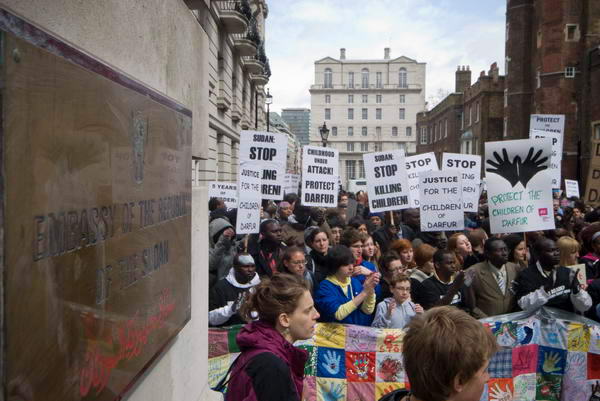
Protesters filled most of the street outside the Sudanese
Embassy in London
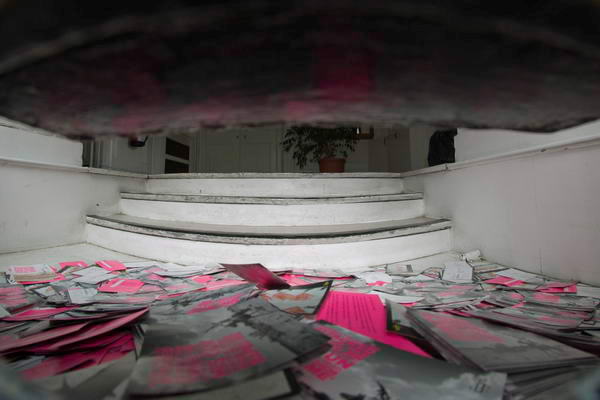
And this was the view through the letterbox, with all the cards posted by
protesters
more pictures
Sunday's protest about the continuing war in Darfur maked 5 years of a conflict
in which 200,000-400,000 are estimated to have died from violence and disease
and 2.5 million people are displaced. The conflict has its roots in global
warming and the associated droughts and desertification leading to a conflict
between nomadic Arabs, backed by the Sudanese government, moving onto the
lands farmed by pastoral non-Arabs.
The fighting has been accompanied by massive violations of human rights including
many horrific murders and mass rapes. The Sudanese government has tried to
cover up details of what is happening there, killing and jailing many eye-witnesses
and obstructing journalists, and has refused to cooperate with the limited
attempts made through the UN to address the situation - such as sending a
hopelessly inadequate African peace-keeping force.
Several thousand demonstrators, including many Sudanese, turned up to protest
outside the Sudanese Embassy opposite St James's Palace in London as part
of a global day of action organised by an international coalition of human
rights groups including Amnesty International, Human Rights Watch and the
Save Darfur Coalition. The rally highlighted the fact that over a million
Sudanese children have been caught up in the bloodshed, displacement and killing.
Among the speakers were survivors from the conflict, faith leaders from the
Muslim, Jewish and Christian communities, Liberal Democrat leader Nick Clegg,
MP and Conservative international development spokesman Andrew Mitchell MP.
There was no speaker from the Labour party, but previously children from Darfur
had met international development minister Shahid Malik, and Gordon Brown
had proposed London as a host for Darfur peace talks.
The rally called for all those involved in the fighting to immediately cease
their attacks on civilians and for the full deployment on an adequately resourced
UN peace-keeping force. It also called on the United Nations - African Union
Mission in Darfur (UNAMID) to actively protect all civilians and especially
children.
more pictures
Woolwich Vaisakhi
Woolwich, London. Saturday April 12, 2008
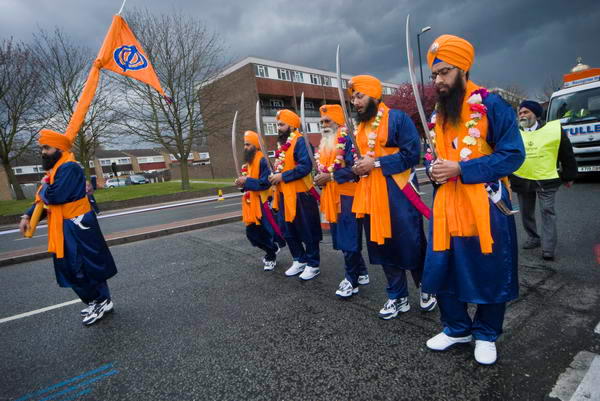
The procession began threatened by dramatic clouds
more pictures
The procession in Woolwich goes between the two Sikh temples, Calderwood
Gurdwara and Mason’s Hill Gurdwara, both built in the nineteenth century
as non-conformist chapels. It isn't as large as the procession in Southall
or East Ham but is certainly a very friendly occasion. One difference from
the Hounslow nagar kirtan I photographed
a couple of weeks ago was that there were only two men bearing Sikh colours
and no Sikh women at the front of the procession.
As we came into the centre of Woolwich, the heavens opened and rain poured
down on the procession. I sheltered in the doorway of the old council offices
and took a few pictures of the procession continuing in the pouring rain.
Fortunately it didn't last long, and as we went up the hill and away from
Mason's Hill for a route around the outskirts of Woolwich, the sun was warm
and doubtless helping everyone to dry out. I left the procession at the top
of the hill and walked down to Woolwich Arsenal.
more pictures
Hostel Residents Demand Better Conditions
Alexandra Court, Stoke Newington, London. Saturday April 12, 2008
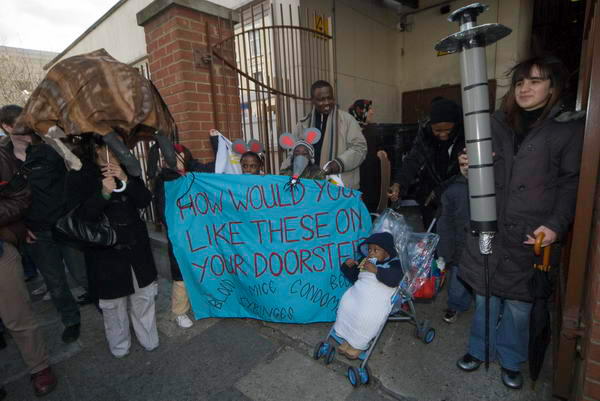 Bed
bugs, mice, syringes, condoms, blood - How would you like these on your doorstep?
Bed
bugs, mice, syringes, condoms, blood - How would you like these on your doorstep?
more pictures
Residents from the Alexandra Court 'temporary' accommodation hostel in Stoke
Newington, London, marched with members of the London Coalition Against Poverty
to Hackney Town Hall on Saturday 12 April, 2008 to demand the council keep
their promises to make temporary accommodation safe to live in. Pictures copyright
© 2008, Peter Marshall. All rights reserved.
When I got bitten by bed bugs as a student 40 years ago, (fortunately they
were rather smaller than the umbrella sized version in the demonstration),
I moved out of the infested flat in days and found another place, losing a
week's rent, but for those rehoused by the council in 'temporary' accommodation
that isn't an option. As well as bed bugs, residents at the hostel also complain
about mice and rats, and the filthy state of the corridors, often used by
addicts and prostitutes, and littered with syringes, used condoms and blood.
Hostel rooms only have flimsy locks, easily forced, and there is no lock
at all on the outside gate to keep out intruders. Heating and hot water seldom
work and residents are often kept awake for hours by fire alarms ringing through
the middle of the night.
Many of those placed in the hostel are mothers with children, whose health
and education is suffering from of the lousy conditions. Despite high payments
for rooms - up to £350 a week, the management has failed to meet its
promises to make improvements, and the council has also failed to take action.
The residents asked for support and the LCAP assisted them in organising
Saturday's demonstration, with around 50 people marching from the hostel to
Hackney Town Hall where they hoped to meet council representatives.
The march started late, and after a few yards police insisted it go down
the pavement as it went down the busy Stoke Newington Road. I had to leave
shortly after the start and was unable to go with them to the council offices
in Mare St.
London Coalition Against Poverty (LCAP) http://www.lcap.org.uk/ , was started
last year and aims to take strategic action around issues related to poverty
- such as homelessness, low wages and benefit payments - in London. Inspired
by the Toronto based militant anti-poverty Ontario Coalition Against Poverty,
it includes members of local activist groups and trade unionists as well as
advice workers from various organisations including the CAB and law centres.
One of their first direct actions last August, reported in the Hackney Gazette,
forced Hackney Council's Homeless Persons Unit to fulfill its statutory duty
and find a place to stay for a homeless man who had been sleeping under bushes
in Stoke Newington. In another case, a young mother who had left temporary
accommodation after violence and harassment was also housed following their
intervention.
As well taking part in direct action, the group aims to advise and help those
directly effected to organise themselves.
more pictures
Shoreditch - Graffiti Capital
Shoreditch, London. Saturday 12 April, 2008
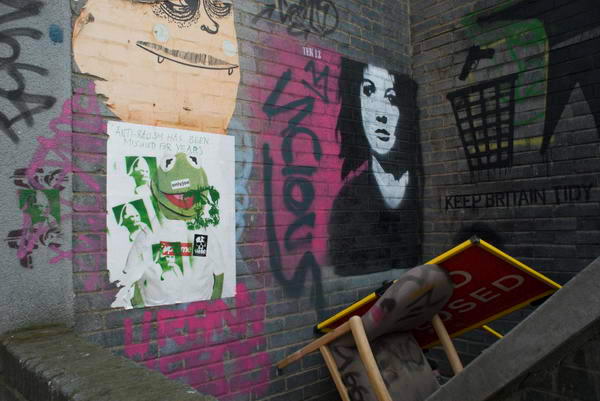
Keep Britain Tidy
more pictures
Shoreditch, immediately north of the City of London used to be an important
centre for the furniture trade as well as housing many other small businesses,
but those disappeared thirty or so years ago, leaving many empty cheap warehouses
that were just what artists needed for studio space. Along with neighbouring
Hoxton it soon became one of the most exciting areas for art in London.
Now, most of the artists have moved out as property prices have again shot
up, and have been replaced by trendy media firms, cafes and clubs. It's had
its festival and
parade - and even
an urban golf tournament.
But there is still plenty of art left, particularly on the walls, where you
can see more graffiti than anywhere else in London.
Also in Shoreditch is one of London's latest squats, again decorated on the
outside by art works. It was rather quiet there when I was taking pictures
early in the morning so I didn't go inside. Many of the buildings in this
area are threatened by demolition as the city expands into the area and they
are now dwarfed by tall office towers.
more pictures
Protest Against Forcible Deportation to Iraq
Home Office, London. Friday 11 April, 2008
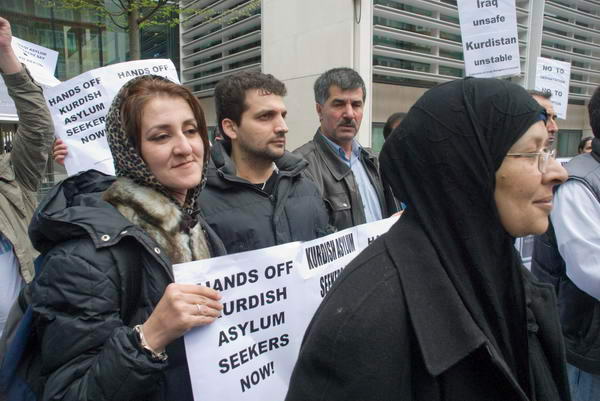
Hands off Kurdish Asylum Seekers Now
more pictures
"Shame on You" chanted the demonstrators, "Home
Office, Shame on You, Gordon Brown, Shame on You", and shameful
indeed is the way this country is treating asylum seekers from many countries
at the moment, and in particular, Iraqi Kurds.
Many aspects of our policy towards asylum seekers fail to treat them as people,
as fellow human beings. Few of them are criminals, but even if they were,
they deserve better treatment. The nation would be in uproar if we treated
animals as badly, and those responsible prosecuted by the RSPCA.
Around 60 Iraqi Kurds were rounded up from detention centres a couple of
weeks ago by armed men in the early hours, forced onto coaches and driven
to Stanstead, where they were put on a German plane that flew them to an airport
in the Kurdish controlled area of Iraq. There, Kurdish armed guards used violence
to force them off the plane and into coaches, which drove them to a nearby
village and simply dumped them, without their luggage. Most had no money,
many had been injured.
They weren't even all from Kurdistan. Among the 55 (they needed more guards
and couldn't fit all those who had been taken to Stanstead on the plane -
so some went back into detention) were men from Baghdad, Mosul and other parts
of Iraq. Areas which even our government says are too dangerous to return
people to. But they were Kurds - so got sent back to the Kurdish north wherever
they came from.
Some are in obvious danger, because of their association with the previous
Iraqi regime, or because of their religion. They were the third plane load
to be taken back, returned to an area where violence and unrest have recently
been very much on the increase.
Most of the speakers were Kurds and spoke in their own language. The only
British speaker, who got the warmest welcome of all, was London's Green MEP,
Jean Lambert. She takes a great interest in the problems
of asylum seekers and refugees, is spokesperson on the subject for the Green
Group in the European Parliament, and was Rapporteur on their latest asylum
report.
Shortly after she finished speaking, and while many of the Kurds were being
photographed with her, there was a violent thunderstorm, and most of us got
rather wet, although I soon went to take shelter under an archway.
more pictures
Panasonic Thames RIB Trip
River Thames, London. Wed 9 April, 2008
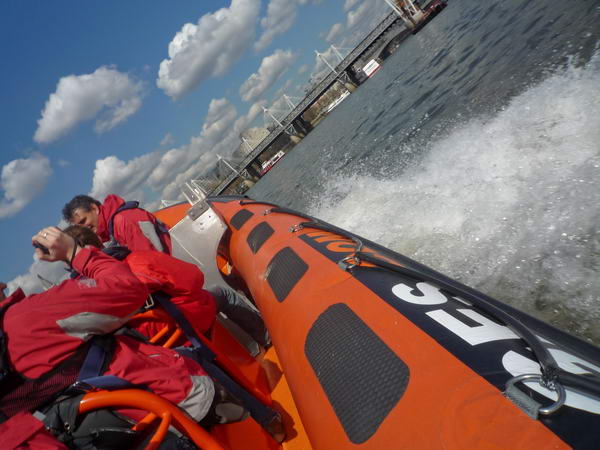
It didn't really tilt quite this much even on the high
speed turns
more pictures
I've often seen the RIB (Rigid Inflatable Boats) speeding along on the river
and wondered what a trip in one would be like. Today, thanks to Panasonic,
I got to find out. It actually felt surprising smooth and safe, although they
did tilt at quite a steep angle when turning sharply at high speed, and I
often felt a need to hold on with one hand while taking pictures. But it was
enjoyable and rather more exciting than the conventional river trips, although
these would be considerably easier to take photographs from.
You can read more about my enjoyable day with Panasonic on >Re:PHOTO
where I also take a short look at the rather nice and very compact
Panasonic DMCFX-500 which I used to take the picture above and all
the others on today's post.
more pictures
Tibetan Freedom Torch Relay, London
Argyle Square, London. Sunday 6 April, 2008
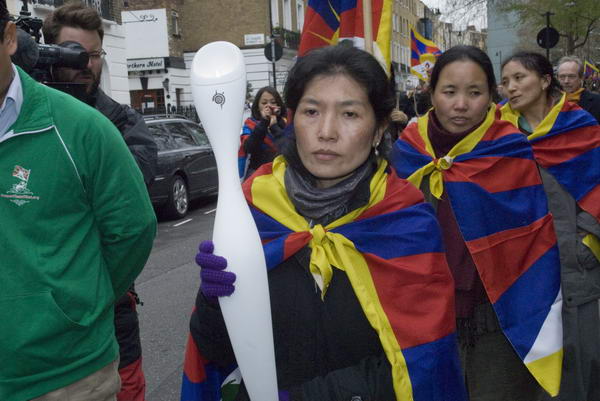
Drapchi Nuns led the Tibetan Freedom Torch relay on
its way from London to Paris
more pictures
The Tibetan Freedom Torch Relay was held in a packed Argyle Square Gardens,
near St Pancras. There were stirring speeches from Kate Hoey, MP, Joanna Lumley,
Lhadon Tethong and others, as well as great music from several Tibetan performers
as well as one-man-band Joe Driscoll who also accompanied Chino in his incredible
rap.
The final performance was a dramatic re-enactment of the Chinese treatment
of Tibetan nationalists, after which Tethong introduced the Freedom Torch
and Team Tibet.
Athletes of Tibetan origin living around the world want to compete for Tibet
in the Olympic Games and formed a national Olympic committee and made an application
to the International Olympic Committee to compete in Beijing. They received
no response to this and last month withdrew their application, demanding the
IOC remove all Olympic Torch relay stops in Tibet, including those in the
Tibetan areas now a part of Chinese provinces.
The Tibet Freedom Torch Relay began in Olympia, Greece on March 10th, the
49th anniversary of the Tibetan Uprising, and has travelled across Europe,
with ceremonies in Budapest, Rome, Munich and Edinburgh and London.
I photographed the torch as a battery-powered version was carried to the
Eurostar terminal at St Pancras, en route - like that other Olympic torch
- to Paris. It was carried by one of the Drapchi nuns. From Paris it will
travel through North and South America and Asia, with its arrival in Tibet
planned for the first day of the Beijing Olympics.
more pictures
London Beijing Torch Relay Shames Olympic Ideals
Bloomsbury and Trafalgar Square, London. Sunday 6th April, 2008
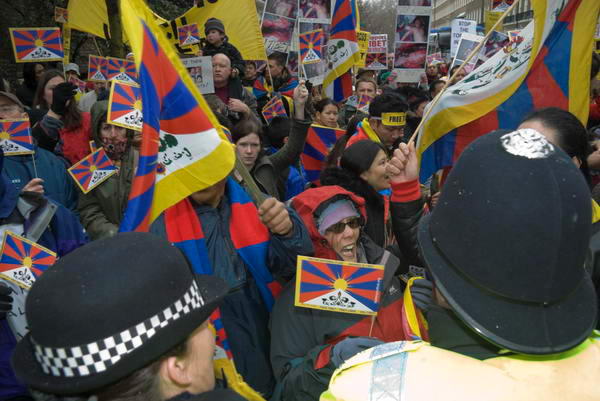
Police surround demonstrators in Great Russell Street
more pictures
Four years ago I photographed the Olympic torch relay as it made its way
through Brixton.
I described it as a rather sad non-event, which seemed to lack the kind of
real community involvement that might have made it worthwhile. Unfortunately
the whole Olympic movement has become so tied up with the commercial exploitation
of sport that it is now impossible to see much evidence of the original ideals
that led to its foundation.
In Brixton it was an organised but low-key event, with little apparent security
and I was able to stand only a couple of feet from Frank Bruno and
Davina McCall as they carried the torch, which had arrived by taxi
and was accompanied by Latin-American dancers as it made its way along the
high street.
Sunday was in contrast a giant security operation, with crowds of police,
and a rather sinister phalanx of Chinese security men. I'd chosen the Bloomsbury
leg as the torch was to have been carried there by the Chinese ambassador,
but these 'secret' plans were altered at the last minute (she carried it instead
in Chinatown) apparently as police decided it would be too dangerous. Instead
the torch was smuggled through hidden inside a vehicle, with no sign of it
visible to the waiting crowds. About all we got to see - apart from a huge
security operation were some very silly looking dancing girls.
There were probably around a thousand demonstrators for human rights in Tibet
on and around Great Russell Street, mainly penned behind barriers in Bedford
Place, roughly ten yards back from the road. Probably about the same number
of Chinese with pro-Olympic banners and flags were allowed to remain behind
banners along the route. This seemed to me to be a very debatable taking of
a particular side by the police.
Similarly when the motorcade had passed, the police attempted to detain the
Tibet supporters, while allowing others to disperse freely. The crowd pushed
through a double line of police close to the Montague Street junction but
were held for some minutes further down the road before eventually being allowed
to disperse down Coptic Street. Presumably this was a delaying tactic to stop
them catching up with the Chinese ambassador in Chinatown.
By this time I'd decided it was probably too late - given the traffic disruption
caused by the event and the likely crowds - to get to a worthwhile position
in Whitehall (a BBC reporter who had been in Bloomsbury and hurried there
had to rely on a man standing on a wall to tell her what was happening –
less practical but not entirely unknown for a photographer, and at least one
of Henri Cartier-Bresson’s well-known pictures from India was taken
by a man up a pole he handed his Leica. But I did walk down to see the crowds
in Trafalgar Square, arriving just minutes after the relay had left.
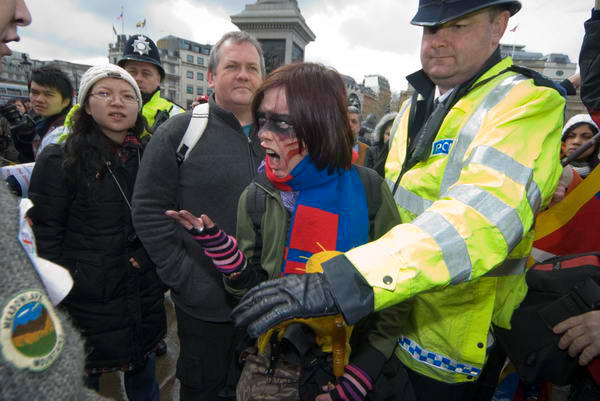
The square was still full of people, with crowds of Chinese arguing heatedly
(if seldom very cogently) with mainly British human rights demonstrators,
and the police in general seemed to be doing a decent job of preventing actual
conflict, warning those who became overheated or abusive. After a short while
they decided to clear the square, and I got on a bus to go the Tibetan Freedom
Torch Relay in Argyle Square.
more pictures
End the Siege of Gaza
Downing Street, Whitehall, London. Saturday 5th April, 2008
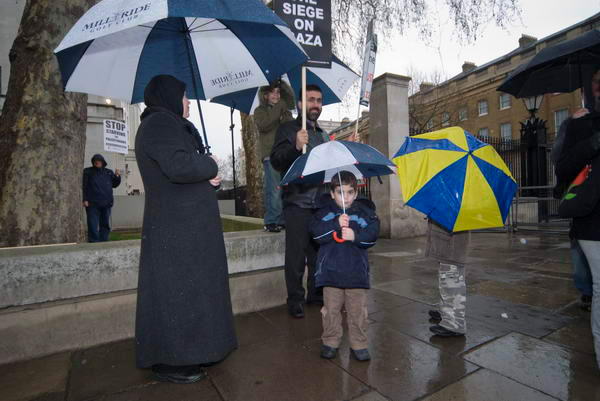
A demonstration on a wet Saturday afternoon at Downing
St
more pictures
Around 50 people turned up to protest opposite Downing Street on Saturday
afternoon calling for and end to the Israeli siege of Gaza. The measures imposed
in September 2007 are an illegal collective punishment against the population
and have already resulted in many dying.
The demonstration was one in a series organised by the Palestine Solidarity
Campaign , which calls on the British government to end the arms trade with
Israel, and to press Israel to abide by international law, end its illegal
occupation and allow the return of refugees.
While the demonstration was taking place on the opposite side of the road
with friendly cooperation from the police, one young man with a Palestinian
flag went and stood on the pavement outside the gates to Downing Street. He
was pulled to one side and questioned, and his flag taken from him and dropped
on the ground, the officers explaining to him that because of the SOCPA law
he was not allowed to demonstrate there. He picked up the flag again, and
one of the officers swore at him, grabbed the flag out of his hands and dropped
it on the pavement.
While I was there the man with the flag was informed that he was being stopped
and searched under (I think) section 44 of the Terrorism Act, 2000. I could
see no evidence of any specific terrorist threat in his behaviour that would
justify this - waving a flag is not terrorism.
Another officer moved in front of me to prevent me from photographing this
and on learning that I was press insisted I move further away as he alleged
I was interfering with the actions of the police - although I was clearly
at a reasonable distance by this time. After making my opinion clear I moved
back as ordered.
At this point a woman officer came up and held her hand in front of my lens.
I told her that this was illegal and that one of the senior officers in the
Met had told a colleague that he would consider it "a sacking offence"
and she hurriedly moved off across the road and away from the area. Unfortunately
I failed to get her number, or that of the other officer who impeded me -
I was still busy trying to take pictures.
I left and returned across the road where the protest was continuing. The
man was still being held by the police when I left the area.
more pictures
Milad 2008 - Eid Milad-Un-Nabi
Procession and Community Day, Tooting. Sat 5 April, 2008
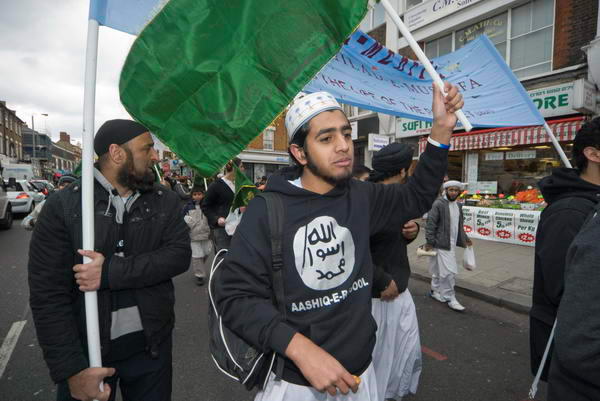
The Juloos (procession) in Tooting
more pictures
Thanks to a signal failures after a cable fire in the Waterloo area, my train
up to London came to a halt in Feltham, then crept forward slowly to Twickenham
where it expired completely. Ten minutes later another service took me the
few hundred yards further to St Margarets, where I abandoned rail and jumped
onto a passing bus to Richmond. Should you ever want a slow and frustrating
ride through some of the more obscure southwest London suburbs I recommend
the 493 route, which even includes a ride past Wimbledon Park and the world's
most famous tennis club before taking you past the dog track and on to Tooting.
Not expecting such travel problems, I hadn't allowed the extra hour or two,
not bothered to take a map, both of which would have been useful. Thanks to
a half-mile run after I abandoned the bus I almost reached the starting point
of the Tooting Sunni Muslim Association's procession for Eid Milad-Un-Nabi
as they started 'promptly' only around 20 minutes late.
The Juloos was to honour the birthday of the Prophet, and was part of an
all-day community event which I attended last year, going into the celebrations
inside the Tooting Leisure Centre and being very impressed by the whirling
dervishes.
This year the weather was not quite as good, and there seemed to be rather
fewer people taking part, although as last year this did include local community
representatives including the Deputy Mayor of Wandsworth, Councillor Mrs.
Claire Clay.
This year I left the procession as it turned into Garrat Lane as I wanted
to go into the centre of London and view some exhibitions.
more pictures
Wall of Sound - Drown Out Blair
Westminster Cathedral, Victoria St, London. Thursday 3 April, 2008
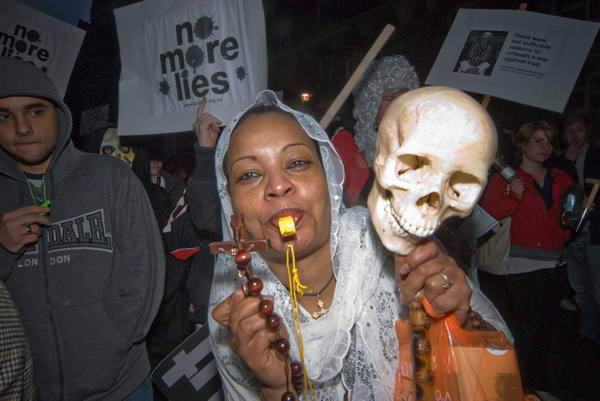
Protest against Tony Blair at Westminster Cathedral
more pictures
Although there was never any real chance that the noise made by protesters
would actually drown out Blair's amplified speech within the rather solid
walls of Westminster's Roman Catholic Cathedral, it could be heard in the
background as his speech was played in the radio news although no mention
was made of the demonstration on those I heard. And of course all of those
entering (except any like Blair himself creeping in - and later out - by a
back entrance) were very aware of the protests as the queued outside to have
their names checked on the register and go through the metal detectors before
being allowed in to the cathedral.
Although Blair may not exactly have lied, it is clear that he and his advisers
set out to deliberately mislead both public and members of parliament in creating
a simplistic and biased dossier based on intelligence that they knew was at
best questionable. It was certainly dishonourable conduct, possibly dishonest
and at best a tragic mistake. Some of the actions taken were almost certainly
illegal, although it is most unlikely that the attempt to get the police to
take action against them will succeed.
It was hard to get an accurate estimate of how many turned up to make a lot
of noise and show their contempt for Blair; possibly around 500. Some made
a silent protest, while others made as much noise as they could.
more pictures
Armed Forces Rally for Pensions
Whitehall, London. Thursday 3 April, 2008
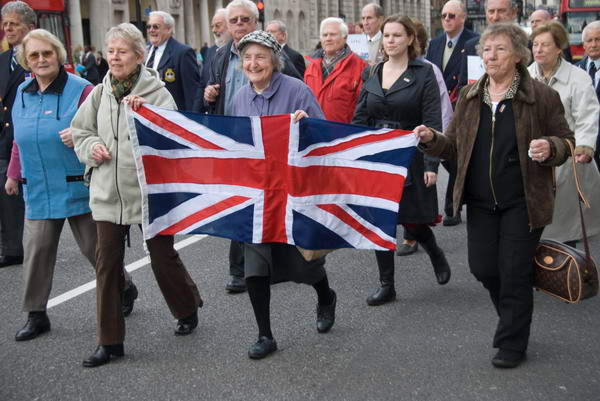
Pensioners march along Whitehall
more pictures
Members of the Armed Forces Pension Group held a short meeting in Whitehall
Place before marching along Whitehall to the Cenotaph where four wreaths were
laid. Their pensions petition has gained more around 120,000 signatures. Among
those laying wreaths was Colin Challen, labour MP for a Leeds constituency.
more pictures
Fossil Fools Day: London protest - Opencast Coal
Albany Courtyard, Piccadilly, London. Tuesday 1 April, 2008
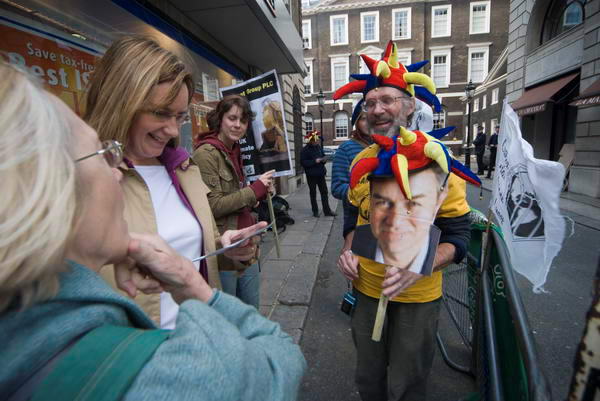
Woman reads a leaflet from demonstrators on Piccadilly
more pictures
The demonstration by the Campaign against Climate Change at the offices of
Argent Group PLC in Piccadilly on April 1, was one of many actions as part
of the global 'Fossil Fools Day.'
Pictures copyright © 2008, Peter Marshall
Argent form half of Miller-Argent who run the UK's largest opencast coal
mine, Ffos-y-Fran in Merthyr Tydfil, South Wales. Just 36 metres from the
nearest houses, extraction will continue for more than 15 years (perhaps as
along as 40 years), producing coal that will add at least 30 million tons
of CO2 to to our atmosphere. Scottish safety standards demand a minimum gap
of 500 metres from housing, but the implementation of a 350 metres limit by
the Welsh office has been delayed - allegedly to allow the Merthyr working
to go ahead.
Despite the misery and health hazards through air-borne dust, diesel fumes
and noise to the 70,000 or so who live in Merthyr (the authorities set up
a Health Impact Study - then refused to accept it when it gave a damning report)
and the dangers of possible disaster to those living on the edge of the 'black
hole', no offers have been made of compensation or relocation.
Thinking globally, the carbon dioxide will add significantly to the world-wide
climate change which already threatens massive disasters, in particular with
densely populated low-lying countries such as Bangladesh likely to become
largely untenable in the medium term future.
This opencast coal mine has only been allowed to go ahead because of close
cooperation between the government and commercial interests backing 'new coal'
and new coal-fired power stations such as Kingsnorth. You can read more about
it on the web sites www.campaigncc.org,
www.thecoalhole.org and www.stopffosyfran.co.uk
Argent's London offices are in Albany Courtyard, a private street off Piccadilly,
part of Albany, one of London's most exclusive addresses, built in 1770-4
for Lord Melbourne and designed by one of the more famous architects of the
time, Sir William Chambers. Shortly after it became the home of the Duke of
York (who had Albany as one of his other titles), before being converted into
managed freehold appartments for rich bachelors in 1802. Available on short
term lets, these saved them the expense of having a house in town. Among famous
residents were Byron, Palmerston, Gladstone, Macauley and Aldous Huxley. About
half of Albany was left to Peterhouse College, Cambridge, by William Stone
who died in 1958.
Around a dozen demonstrators turned up at 4pm and set up behind barriers
watched by rather more police from three vans and a police car, with a police
photographer taking extensive video and photographs. A manager from the Albany
came and talked to the demonstrators, taking a document about the mine and
promising to deliver it to his tenants at Argent Group PLC.
A steady stream of pedestrians walking along Piccadilly took leaflets and
quite a few expressed their support for action against climate change (only
one stopped to argue against it while I was present,) and some passing motorists
hooted in support.
more pictures
Fossil Fools Day: No New Coal
Parliament Square, Westminster, London. Tuesday 1 April, 2008
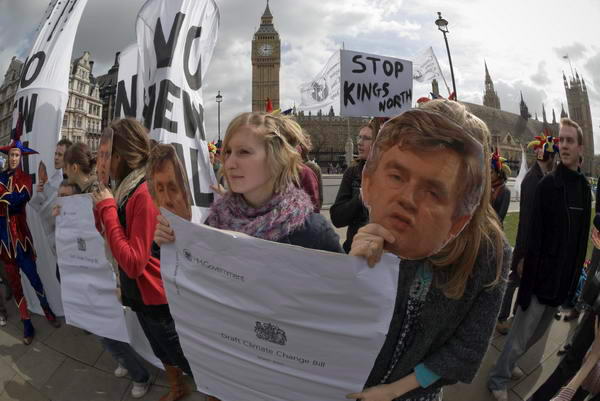
protesters with power station cooling towers in Parliament Square
more pictures
Students from 'People and Planet' along with other climate activists
came to Parliament Square, London on April 1 as a part of the international
Fossil Fool's Day protest.
Around a hundred came to protest about the plans to build a new coal-fired
power station at Kingsnorth in Kent, the first of eight such major carbon-emitters
being planned. Students brought with them three large white cooling towers,
each with a large message 'NO NEW COAL' and one with rather nice grime dripping
from its upper lip.
Many of the students also held cutouts of Gordon Brown's face as they shouted
advice to him that this programme compromises the governments policy on carbon
emissions, and several held posters showing the Draft Climate Change Bill,
one of which, held by a jester, was set alight with the help of some lighter
fuel.
Students went on to lobby their MPs, and a couple, including the Labour MP
for Reading West, Martin Salter came out into Parliament Square to
meet students from their constituencies.
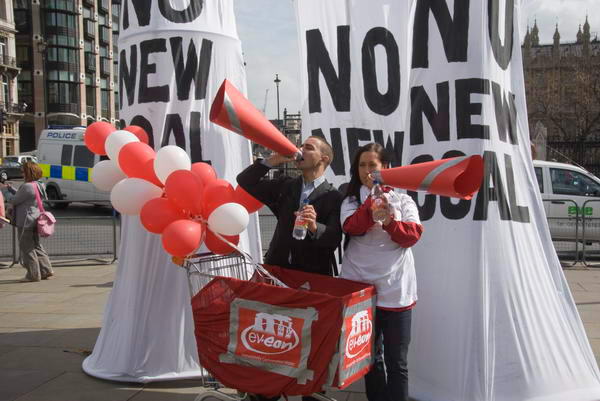
The launch of 'ev-eon Unnaturally Carbonated Water' a new carbon
capture technology to be used at E.ON's Kingsnorth Power Station, which began
earlier at the London Eye was continued here. 'Ev-eon' uses the CO2 from coal
burning to carbonate water which you then swallow. And if you can swallow
the governments coal-fired policy you can swallow anything. And of course
with Ev-eon, should you burp, breathe or otherwise release that CO2 you've
swallowed, global warming is all your fault - and not E.ON's.
more pictures
top of page
All pictures on this section of the site are ©
Peter Marshall 2008; to buy prints or for permission to reproduce pictures
or to comment on this site, or for any other questions, contact
me.



























